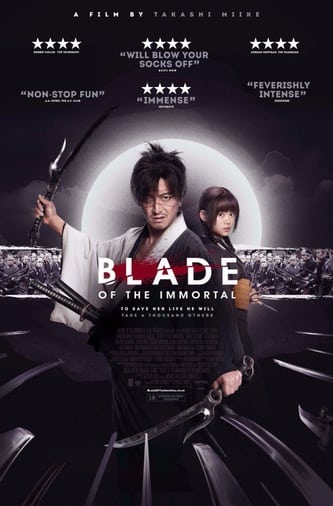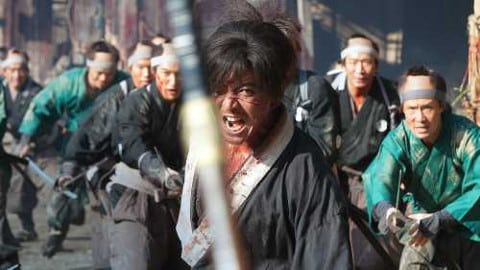Blade of the Immortal (2017)
Directed by: Takashi Miike
Written by: Hiroaki Samura
Starring: Hana Sugisaki, Hayato Ichihara, Sôta Fukushi, Takuya Kimura
AKA MUGEN NO JUNIN
Japan
IN SELECTED CINEMAS NOW
RUNNING TIME: 140 mins
REVIEWED BY: Dr Lenera, Official HCF Critic
Japan during the mid-Tokugawa Shogunate period. Manji is a highly skilled samurai who fails to save the life of his sister Machi. A woman who claims to be 800 years old implants “sacred bloodworms” into his body which regerate/heal any damaged part of his body and thereby curse him with immortality. In order to be freed from this eternal life, he vows to kill 1000 evil men. 53 years later, the murderous Kagehisa Anotsu and the Itto-ryu Clan, who are trying to take over Japan, kill the father of young Rin Asano, a girl who resembles Machi. She approaches Manji and requests his aid as bodyguard to help her carry out her revenge. Initially reluctant, Manji changes his mind when he realises that he has a final chance to matter to someone….
It’s unbelievable that Blade Of The Immortal is the maverick Japanese filmmaker Takashi Miike’s 100th film, especially when one considers that he’s only been churning them out since 1991. The 53 year old has slowed down a little of late, but Blade Of The Immortal, partly made by Warner Bros, is mad Miike’s most prestigious film in some time and I was so happy that I was actually able to see a Miike film in cinemas for once, even though personally I’ve only been a fan for a couple of years as it took me a while to really get into this filmmaker whose work always has an appealing quirkiness – when it isn’t totally insane – even if the end result is sometimes below par, something that’s bound to be the case when you’ve made 100 bleeding films. Blade Of The Immortal will no doubt be mostly compared with 2009’s 13 Assassins which was his previous samurai epic that got a decent release, though he’s made others. That film proved his thorough mastery of the samurai epic as well as being one of his most carefully made films, and was a very tough act to follow. Blade Of The Immortal falls just short of 13 Assassins, though the director’s fans and folk who just want a good old blood-soaked historical actioner should still be satisfied. Based on a manga which was previously made into an anime for TV, it’s more comic book-esque than the other film, with a few fantastical elements and quite a few characters with odd outfits and unique fighting styles, though at times I wondered if Miike was trying to channel Hong Kong wuxia actioners and traditional martial arts pictures as well as some of the classic samurai pictures. It’s also looser and a tad less well structured, but when there’s so much gory fun to be had one can often forgive things like that.
The opening scene, which is in black and white and evokes the great samurai films of old like the early Akira Kurosawa masterpieces, shows how our hero [or should that be anti-hero?] making a terrible mistake when he puts down his sword in front of attackers who are holding his sister Machi captive, before engaging in a battle in which his enemies number 100 in a sequence which should make any fan of samurai pictures leap for joy. Having watched 13 Assassins the evening before, I was reminded of how well Miike stages and films this kind of action. The fighting is messy and undisiplined but still showcases considerable skill, while there’s just enough handheld camerawork to convey a sense of the freneticness of what we are witnessing and what it would be like to be there, without lapsing into full-on shakycam where you can’t see what the hell’s going on, while everynow and again we get some long shots or even a bird’s eye view of the action. Manji vanquishes all of his opponents but begins to die from his wounds – until the mysterious Yaobikuni puts these “bloodworms” into his body and we see a severed hand re-attach itself to the body with the typically poor Miike CGI. I’ve never understood why he often settles for digital effects of such poor quality, but then who knows what Miike is thinking half the time anyway?
Cut to 53 years later and we have the good old clash between differing martial arts schools and fighting styles, here between what is basically formality and diversity. Most dojos stick to one specific form and don’t allow for any deviance. However, the Clan are comprised of people who all bring something different to the table. Of course they’re immediately introduced as bad guys who kill a man infront of his young daughter and then presumably rape and kill the mother, but the story does ask you to consider which approach to fighting or indeed life is better – but then I’ve often found much of Miike’s work to have deeper meanings even if his critics consider him somebody just interested in shocking people, something patently untrue especially these days. While Manji, shaken by her resemblence to his dead daughter, initially refuses Rin’s request to be a bodyguard and teacher, he reconsiders when Rin is attacked by the Itto-ryu member Sabato Kuroi who has the severed head of Rin’s mother mounted on his left shoulder. Word of Sabato’s death soon reaches Kagehisa after setting up an Itto-ryu contract for a place in the shogunate, but despite the 140 min running time, politics mostly takes second place to action as Kagehisa sends various aides to try to kill Manji and the fighting eventually begins to escalate.
Having all these duels taking place between one guy who is immortal and other guys who aren’t does somewhat diminish the excitement somewhat, despite the variety of fighters sent to slay him, though there are good stabs at unpredictability sometimes, like the female martial arts martial who, after her koto transforms into the cooolest three section staff you will ever see, batles Manji for a bit before suddenly becomeing really remoseful at all the killing she’s had to do. And at one point Manji does fight one other immortal opponent in one of the film’s best written, acted and staged scenes though if you’re a Monty Python fan you’ll probably expect one of the characters to remark: “It’s only a flesh wound” during one moment. There’s considerably less of the comparative realism of 13 Assassins during most of the mayhem with a fair bit of wuxia-style jumping around, and similarly to that film not much of the totally bonkers over the top violence that initially made Miike’s name, but the red stuff flows throughout, there are plenty of severed limbs, and the bodycount must be one of the highest in a film for some time. Along the way good and evil are blurred by having most of the supposed villains have back stories which made them the way they are, and eventually the film almost begins to play out like a Greek tragedy and you may be surprised how much you care for some of the characters.
Manji being less an immortal in the superhero sense of the word, but rather immortal in the way that we often see ghosts represented – as people forced to stay on Earth and forever regret their sins – cannot help but provide a slightly moving centre to the story and Takuya Kimura, a Japanese matinee idol who seems to enjoy getting progressively more scarred and bloody, evokes the character’s regret, torment and world weariness quite well throughout. Hana Sugisaki seems to prefer shouting her lines to speaking them, though it must have been a hard role for any young actress. Her character often has weapons held against her neck, is punched, elbowed, kicked, stabbed and even has her tongue slit. Considering that most American films shy away from showing children being harmed on screen, some sensitive viewers may find these moments hard to take. The relationship between Manji and Rin, possibly inspired by the one in Leon, is odd in that it’s often a master/student relationship yet Rin never seems to actually learn anything. I guess this is just Miike subverting expectations again, and it’s amusing that she has only one trick up her sleeves, a trick she seems to learn herself – specifically, knives literally hidden up her sleeves – and she’s not very good with them. But I did emotionally invested myself in the pairing and both performers have a good chemistry together – though at times it’s Sota Fukushi who steals the film as the principal villain, a man who represents a darker, more violent but possibly more appropriate future for the samurai warrior.
It’s possible that the mid-section could have benefitted from being shortened, though there’s an interesting mythology existing on the edge of the film which is oddly coherent. Sound is often used very well, such as a bird’s song breaking through the deathly silence after a massacre. I don’t think that overall Blood Of The Immortal will be considered one of Miike’s most notable works, though Miike made it problematic for himself when 13 Assassins turned out so damn great. At the end of the day it doesn’t give us much that is new [the basic plot isn’t that different from Logan] except for certain details and events. But it’s still a bloody good time and proves that quantity can sometimes equal quality.










Be the first to comment